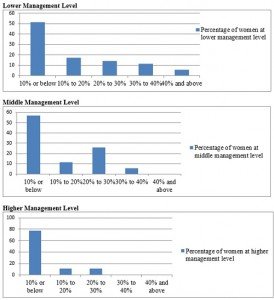On March 8, 2013, the Jewish Museum of Florida, the only museum dedicated to the story of 250 years of Florida Jewish heritage, announced the winners of the 17th Annual “Breaking the Glass Ceiling” awards for five women who have been successful in fields generally dominated by men. What is Glass Ceiling?
Introduction
Glass Ceiling is the invisible but real barrier that obstructs women from rising to the upper rungs of the corporate ladder, irrespective of their qualifications and achievements. In theory, nothing prevents women from rising as high as men. However, in practice, there are still such barriers due to the implicit prejudice on the basis of age, ethnicity, political, religious affiliation or sex.
In a recent interview, Susan Lucas-Conwell, the Global CEO at “Great Place to Work”, gave keen perspective on how building and maintaining great work place culture drives business towards success. According to Susan, many of the challenges that women face in the workplace are the same as those for men like
- Parenting
- Multi-tasking
- Work/Life balance
- Juggling many responsibilities
A study made by Catalyst.org reported, Fortune 500 companies with three or more women on the Board outperform other companies with 53% more returns on equities, 42% more return on sales and 66% more return on invested capital. Yet, according to National Center for Women and Information Technology women executives account for only 6% of chief executives at the top 100 tech companies.
I carried out a survey on 1st year PGDM participants of IIM Indore who had prior work experience in different companies and survey revealed that still very low percentage of women pertain to higher management.
Survey was conducted to find the percentage of women in their respective companies, at three different levels:
- Lower management level
- Middle management level
- Higher management level
The survey responses show a declining trend in number of women employees as we move up the corporate hierarchy. At the entry level, female employees were said to form more than 30% of the workforce in about 18% of the responses. This figure dipped to 5% at the middle management level and less than 1% at the top management level. This clearly shows that there are fewer women holding higher management positions even though a significantly large number of women are employed at the entry level.
Glass Ceiling as a Sticky Floor
It’s not more women at the upper levels but the right kind of women at all levels which will counter architectural flaws of the gender inequity. It will not only help more women push past the Glass Ceiling, but also encourage them to disengage themselves from the sticky floor- Glass Ceiling.
One of the specific challenges faced by women is wage gap
UC Davis (University of California) published a study in 2011 that examined the 400 largest companies in California. This study showed that only 9.7% of board room seats or top paying executive positions were held by women. 34% percent had no women on their executive board and none of the companies in the study had complete female board. In addition, none of the companies had a gender-balanced board.
When women or minorities have made gains or achieved some success in the workplace, they refer it to Cracks in the Glass Ceiling. Women have made progress but still have a challenge to make what men make for the same job and to attain the promotions that will place them in leadership roles. As MD of Britannia Industries, Vinita Bali spoke out that more and more women are cracking the Glass Ceiling but we still have work to do at the middle management levels to increase the number of women.
Techniques to crack Glass Ceiling
- Maintain Job flexibility: Encourage organizations to
- Provide option of job sharing and mentoring
- Provide option of flexible work arrangements
- Develop a gender-neutral environment
- Hire help: Hire a trusted nanny who can be there for the events you may miss due to work responsibilities
- Avoid jobs with extensive travel requirements: If one’s job requires excessive travel prior to motherhood, one must try to negotiate a way to have subordinates assume some of the travel responsibilities
- Rely on emotional intelligence: Women must rely on their emotional intelligence by staying true to and acting from their innate strengths (like creativity and collaboration) in their everyday approach to work and overcoming the inevitable obstacles
- Provide extra benefits for women employees: Significant emphasis must be placed on the benefits that an organization can offer to women like
- Onsite childcare
- Maternity benefits
- Women’s networking groups
- Mentoring and development
- Provide orientation programmes: Organize comprehensive professional development programmes aimed at developing and delivering.
Conclusion
The article analyzes the glass ceiling effect and the possible reasons behind its existence. It looks at the other possibilities for having fewer women in the higher echelons of management- such as ‘internal glass ceiling’ and ‘sticky floor’. While the corporate world acknowledges that such discrimination does exist, they are yet to take serious measures to curb it. This article suggests certain steps that can be taken to rectify the current situation.
[The article has been written by Potti Rajesh. He has completed his PGDM from IIM Indore and did his engineering in electronics. In his spare time, he loves to read magazines and write articles and aspires to start an e-commerce venture in future.]

































